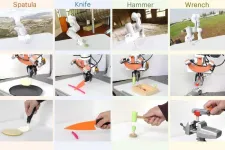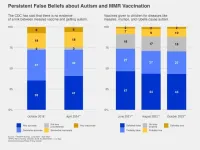(Press-News.org) CAMBRIDGE, MA – Let’s say you want to train a robot so it understands how to use tools and can then quickly learn to make repairs around your house with a hammer, wrench, and screwdriver. To do that, you would need an enormous amount of data demonstrating tool use.
Existing robotic datasets vary widely in modality — some include color images while others are composed of tactile imprints, for instance. Data could also be collected in different domains, like simulation or human demos. And each dataset may capture a unique task and environment.
It is difficult to efficiently incorporate data from so many sources in one machine-learning model, so many methods use just one type of data to train a robot. But robots trained this way, with a relatively small amount of task-specific data, are often unable to perform new tasks in unfamiliar environments.
In an effort to train better multipurpose robots, MIT researchers developed a technique to combine multiple sources of data across domains, modalities, and tasks using a type of generative AI known as diffusion models.
They train a separate diffusion model to learn a strategy, or policy, for completing one task using one specific dataset. Then they combine the policies learned by the diffusion models into a general policy that enables a robot to perform multiple tasks in various settings.
In simulations and real-world experiments, this training approach enabled a robot to perform multiple tool-use tasks and adapt to new tasks it did not see during training. The method, known as Policy Composition (PoCo), led to a 20 percent improvement in task performance when compared to baseline techniques.
“Addressing heterogeneity in robotic datasets is like a chicken-egg problem. If we want to use a lot of data to train general robot policies, then we first need deployable robots to get all this data. I think that leveraging all the heterogeneous data available, similar to what researchers have done with ChatGPT, is an important step for the robotics field,” says Lirui Wang, an electrical engineering and computer science (EECS) graduate student and lead author of a paper on PoCo.
Wang’s coauthors include Jialiang Zhao, a mechanical engineering graduate student; Yilun Du, an EECS graduate student; Edward Adelson, the John and Dorothy Wilson Professor of Vision Science in the Department of Brain and Cognitive Sciences and a member of the Computer Science and Artificial Intelligence Laboratory (CSAIL); and senior author Russ Tedrake, the Toyota Professor of EECS, Aeronautics and Astronautics, and Mechanical Engineering, and a member of CSAIL. The research will be presented at the Robotics: Science and Systems Conference.
Combining disparate datasets
A robotic policy is a machine-learning model that takes inputs and uses them to perform an action. One way to think about a policy is as a strategy. In the case of a robotic arm, that strategy might be a trajectory, or a series of poses that move the arm so it picks up a hammer and uses it to pound a nail.
Datasets used to learn robotic policies are typically small and focused on one particular task and environment, like packing items into boxes in a warehouse.
“Every single robotic warehouse is generating terabytes of data, but it only belongs to that specific robot installation working on those packages. It is not ideal if you want to use all of these data to train a general machine,” Wang says.
The MIT researchers developed a technique that can take a series of smaller datasets, like those gathered from many robotic warehouses, learn separate policies from each one, and combine the policies in a way that enables a robot to generalize to many tasks.
They represent each policy using a type of generative AI model known as a diffusion model. Diffusion models, often used for image generation, learn to create new data samples that resemble samples in a training dataset by iteratively refining their output.
But rather than teaching a diffusion model to generate images, the researchers teach it to generate a trajectory for a robot. They do this by adding noise to the trajectories in a training dataset. The diffusion model gradually removes the noise and refines its output into a trajectory.
This technique, known as Diffusion Policy, was previously introduced by researchers at MIT, Columbia University, and the Toyota Research Institute. PoCo builds off this Diffusion Policy work.
The team trains each diffusion model with a different type of dataset, such as one with human video demonstrations and another gleaned from teleoperation of a robotic arm.
Then the researchers perform a weighted combination of the individual policies learned by all the diffusion models, iteratively refining the output so the combined policy satisfies the objectives of each individual policy.
Greater than the sum of its parts
“One of the benefits of this approach is that we can combine policies to get the best of both worlds. For instance, a policy trained on real-world data might be able to achieve more dexterity, while a policy trained on simulation might be able to achieve more generalization,” Wang says.
Because the policies are trained separately, one could mix and match diffusion policies to achieve better results for a certain task. A user could also add data in a new modality or domain by training an additional Diffusion Policy with that dataset, rather than starting the entire process from scratch.
The researchers tested PoCo in simulation and on real robotic arms that performed a variety of tools tasks, such as using a hammer to pound a nail and flipping an object with a spatula. PoCo led to a 20 percent improvement in task performance compared to baseline methods.
“The striking thing was that when we finished tuning and visualized it, we can clearly see that the composed trajectory looks much better than either one of them individually,” Wang says.
In the future, the researchers want to apply this technique to long-horizon tasks where a robot would pick up one tool, use it, then switch to another tool. They also want to incorporate larger robotics datasets to improve performance.
“We will need all three kinds of data to succeed for robotics: internet data, simulation data, and real robot data. How to combine them effectively will be the million-dollar question. PoCo is a solid step on the right track,” says Jim Fan, senior research scientist at NVIDIA and leader of the AI Agents Initiative, who was not involved with this work.
###
This research is funded, in part, by Amazon, the Singapore Defense Science and Technology Agency, the U.S. National Science Foundation, and the Toyota Research Institute.
END
A technique for more effective multipurpose robots
With generative AI models, researchers combined robotics data from different sources to help robots learn better.
2024-06-03
ELSE PRESS RELEASES FROM THIS DATE:
Oral nucleoside antiviral is progressing toward future pandemic preparedness
2024-06-03
May 23, 2024
Obeldesivir (GS-5245), a novel investigational small molecule oral antiviral, represents a new tool in the ongoing effort to prepare for future pandemics.
Several researchers at the University of North Carolina at Chapel Hill’s Gillings School of Global Public Health are co-authors of a new study published online May 22 by the journal Science Translational Medicine.
The study shares findings from an academic-corporate partnership between biopharmaceutical company Gilead Sciences and the Sheahan ...
Shape and depth of ocean floor profoundly influence how carbon is stored there
2024-06-03
Key takeaways
The movement of carbon between the atmosphere, oceans and continents — or carbon cycle — regulates Earth’s climate, with the ocean playing a major role in carbon sequestration.
A new study finds that the shape and depth of the ocean floor explain up to 50% of the changes in depth at which carbon has been sequestered there over the past 80 million years.
While these changes have been previously attributed to other causes, the new finding could inform ongoing efforts to combat climate change through marine carbon sequestration.
The movement of carbon between the atmosphere, oceans and continents — the carbon ...
Airplane noise exposure may increase risk of chronic disease
2024-06-03
FOR IMMEDIATE RELEASE
Monday, June 3, 2024
Contact:
Jillian McKoy, jpmckoy@bu.edu
Michael Saunders, msaunder@bu.edu
##
Airplane Noise Exposure May Increase Risk of Chronic Disease
A new study found that people who were exposed to higher levels of noise from aircraft were more likely to have a higher body mass index, an indicator for obesity that can lead to stroke or hypertension. The findings highlight how the environment—and environmental injustices—can shape health outcomes.
Research has shown that noise from airplanes and helicopters flying overhead are far more bothersome to people than noise from other modes of transportation, ...
Mental health, lack of workplace support are leading factors driving nurses from jobs
2024-06-03
Coworker and employer support are strong predictors of nurses planning to stay in their jobs, while symptoms of depression are linked to nurses planning to leave, according to a study conducted at the height of the COVID-19 pandemic by researchers at NYU Rory Meyers College of Nursing.
The research—published in the Online Journal of Issues in Nursing, a journal of the American Nurses Association—examines both pandemic-related factors and the overall work environment for nurses and can help organizational ...
U.S. health departments experience workforce shortages and struggle to reach adequate staffing levels in public health
2024-06-03
Gaps persist in hiring enough U.S. public health workers and health departments continue to face challenges in recruiting new employees, according to a new study by Columbia University Mailman School of Public Health and Indiana University. Insufficient funding, a shortage of people with public health training, and a lack of visibility for public careers, in addition to lengthy hiring processes, are cited as barriers contributing to an absence of progress for achieving a satisfactory level of workers. The results ...
Redox Science Meets Medicine at the 26th International Conference on Redox Medicine 2024 this June in Paris
2024-06-03
Redox Science Meets Medicine at the 26th International Conference on Redox Medicine 2024 this June in Paris
The 26th International Conference on Redox Medicine 2024 will take place this month, on June 27-28 at Fondation Biermans-Lapôtre in Paris, France.
With 41+ communications and participants from 20 different countries, the conference promises a diverse exchange of knowledge and ideas.
The sessions of the conference are organized around key topics, with each speaker addressing a specific ...
Albert Einstein College of Medicine names Marla Keller, MD, Executive Dean
2024-06-03
June 3, 2024—(BRONX, NY)—Marla Keller, M.D., a national leader in academic medicine and in clinical and translational research and training, has been appointed executive dean at Albert Einstein College of Medicine. In this role, Dr. Keller will work closely with Yaron Tomer, M.D., the Marilyn and Stanley M. Katz Dean at Einstein, other executive leaders at the College of Medicine and Montefiore, and the Board of Trustees to achieve the vision for the institution. As Einstein’s second most senior officer, she will drive strategic planning for the College of Medicine and provide guidance across all academic and research programs.
Dr. ...
Two-pronged attack strategy boosts immunotherapy in preclinical studies
2024-06-03
JUNE 3, 2024, NEW YORK – A novel immunotherapy approach developed by Ludwig Cancer Research scientists employs a two-pronged attack against solid tumors to boost the immune system’s ability to target and eliminate cancer cells.
The research focuses on an immunotherapy called adoptive cell transfer (ACT), which involves extracting T cells from a patient, enhancing their ability to fight cancer, expanding them in culture and reinfusing them into the patient’s body.
“While T cell therapies have shown tremendous ...
Microscopic defects in ice shape how massive glaciers flow, study shows
2024-06-03
As they seep and calve into the sea, melting glaciers and ice sheets are raising global water levels at unprecedented rates. To predict and prepare for future sea-level rise, scientists need a better understanding of how fast glaciers melt and what influences their flow.
Now, a study by MIT scientists offers a new picture of glacier flow, based on microscopic deformation in the ice. The results show that a glacier’s flow depends strongly on how microscopic defects move through the ice.
The researchers found they could estimate ...
False belief in MMR vaccine-autism link endures as measles threat persists
2024-06-03
As measles cases rise across the United States and vaccination rates for the MMR (measles, mumps, rubella) vaccine continue to fall, a new survey finds that a quarter of U.S. adults do not know that claims that the MMR vaccine causes autism are false.
The Centers for Disease Control and Prevention (CDC) has said there is no evidence linking the measles vaccine and getting autism. But 24% of U.S. adults do not accept that – they say that statement is somewhat or very inaccurate – and another 3% are not sure, according to the survey by the Annenberg Public Policy Center (APPC) of the University of Pennsylvania. About three-quarters of those surveyed ...
LAST 30 PRESS RELEASES:
Normalizing blood sugar can halve heart attack risk
Lowering blood sugar cuts heart attack risk in people with prediabetes
Study links genetic variants to risk of blinding eye disease in premature infants
Non-opioid ‘pain sponge’ therapy halts cartilage degeneration and relieves chronic pain
AI can pick up cultural values by mimicking how kids learn
China’s ecological redlines offer fast track to 30 x 30 global conservation goal
Invisible indoor threats: emerging household contaminants and their growing risks to human health
Adding antibody treatment to chemo boosts outcomes for children with rare cancer
Germline pathogenic variants among women without a history of breast cancer
Tanning beds triple melanoma risk, potentially causing broad DNA damage
Unique bond identified as key to viral infection speed
Indoor tanning makes youthful skin much older on a genetic level
Mouse model sheds new light on the causes and potential solutions to human GI problems linked to muscular dystrophy
The Journal of Nuclear Medicine ahead-of-print tip sheet: December 12, 2025
Smarter tools for peering into the microscopic world
Applications open for funding to conduct research in the Kinsey Institute archives
Global measure underestimates the severity of food insecurity
Child survivors of critical illness are missing out on timely follow up care
Risk-based vs annual breast cancer screening / the WISDOM randomized clinical trial
University of Toronto launches Electric Vehicle Innovation Ontario to accelerate advanced EV technologies and build Canada’s innovation advantage
Early relapse predicts poor outcomes in aggressive blood cancer
American College of Lifestyle Medicine applauds two CMS models aligned with lifestyle medicine practice and reimbursement
Clinical trial finds cannabis use not a barrier to quitting nicotine vaping
Supplemental nutrition assistance program policies and food insecurity
Switching immune cells to “night mode” could limit damage after a heart attack, study suggests
URI-based Global RIghts Project report spotlights continued troubling trends in worldwide inhumane treatment
Neutrophils are less aggressive at night, explaining why nighttime heart attacks cause less damage than daytime events
Menopausal hormone therapy may not pose breast cancer risk for women with BRCA mutations
Mobile health tool may improve quality of life for adolescent and young adult breast cancer survivors
Acupuncture may help improve perceived breast cancer-related cognitive difficulties over usual care
[Press-News.org] A technique for more effective multipurpose robotsWith generative AI models, researchers combined robotics data from different sources to help robots learn better.





